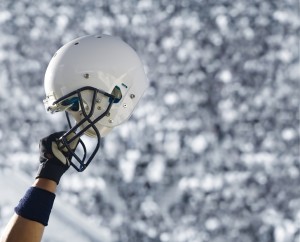In 1888, college football officials voted to allow tackling below the waist. Before long, protective padding was required for players. Helmets, however, were considered optional.
One of the first known helmets designed specifically for the game was made by a Maryland shoemaker for a Naval Academy midshipman named Joseph Reeves, who was told by a doctor that he had to give up football or else risk death from another kick in the head. Determined to play in the 1893 Army-Navy game, Reeves consulted the shoemaker to create a protective device for his head.
 In those early days, a football helmet looked about the same as an early aviator’s cap: an egg-shaped skullcap made of soft leather, with ear flaps and light padding on the inside. Hardly a helmet, it was known as a “head harness.” But by 1915, more padding and flaps were being added, along with ear holes so that athletes could hear plays being called.
In those early days, a football helmet looked about the same as an early aviator’s cap: an egg-shaped skullcap made of soft leather, with ear flaps and light padding on the inside. Hardly a helmet, it was known as a “head harness.” But by 1915, more padding and flaps were being added, along with ear holes so that athletes could hear plays being called.
A Move to Mass Production
By 1917, helmets were being mass produced by manufacturers like Rawlings and Spalding. The latest innovation was “suspension” — building in a “cradle” with straps of fabric that kept the skull a small distance away from the outer shell, absorbing the impact better and allowing for ventilation.
It wasn’t until the 1930s that face masks started being incorporated, thanks to a sporting goods store owner in Indiana who fixed a rubber-covered wire mask to the front of a helmet.
A Chicago manufacturer created the first plastic helmet in the 1940s, and included a chin strap in his new design. The shape also got some customization, from the original slightly flat top to a teardrop shape, which allowed the impact of a collision to slide to one side or the other instead of taking the blow head-on.
By this time, helmets were being required in more settings. The last NFL player to play in a game without a helmet was Dick Plasman of the Chicago Bears in 1940. (Chicago won that game against the Washington Redskins by a whopping 73-0.)
By the 1950s, nobody was wearing leather helmets anymore. Instead, polymers were the material of choice. Along with requiring helmets to be worn by professional players, the NFL also recommended face masks for players, and instituted new rules that prohibited players from grabbing face masks of those on the opposite team.
The Modern Era
The 1970s and 80s brought more refinement and regulation to the design of helmets. In even more recent years, the standard helmet has been fitted with a visor (to protect from sun glare), embedded sensors that record data on hits a player receives (such as the force and direction of the impact) and even headsets that allow coaches to call directions to the players in the midst of a game.
 Perhaps the most important development in recent years, with the rise to prominence of traumatic head injuries sustained by NFL players, is the cushioning designed to protect against concussion.
Perhaps the most important development in recent years, with the rise to prominence of traumatic head injuries sustained by NFL players, is the cushioning designed to protect against concussion.
More recently, manufacturers have been designing helmets specifically with concussion prevention in mind. In 2007, Schutt Sports announced a next-generation design that includes a shock-absorbing face guard. The helmet is already in use by the Air Force Academy and Penn State.
Who We Are
The Brain Injury Law Center specializes in helping victims of traumatic head injury get justice and receive adequate compensation to assist in their recovery. If you’ve suffered from a debilitating concussion or another brain injury, contact us at (757) 244-7000 for a no-cost consultation.


